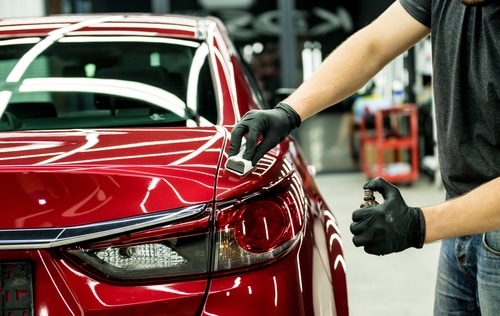Ceramic coating is a popular option for protecting and enhancing the appearance of a vehicle. It involves applying a thin layer of ceramic material to the vehicle’s surface, which creates a protective barrier that helps prevent damage from environmental elements and other factors. In this blog, we’ll take a closer look at the process of ceramic coating a vehicle, including the steps involved and the benefits it can offer.
Step 1: Preparing the Vehicle
Before the ceramic coating can be applied, the vehicle needs to be thoroughly cleaned and prepared. This typically involves thoroughly washing dirt and debris from the vehicle’s surface, followed by a clay bar treatment to remove any embedded contaminants stuck to the surface. After the clay bar treatment, the vehicle is usually polished to remove any imperfections in the paint, such as scratches or swirl marks.
Step 2: Applying the Ceramic Coating
Once the vehicle is clean and prepared, it’s time to apply the ceramic coating. The first step in this process is to apply the base layer, which is typically a liquid ceramic coating spread over the vehicle’s surface using a soft applicator pad. The base layer is designed to bond with the paint and create a robust and durable surface that can withstand exposure to the elements.
After the base layer has been applied, the vehicle is left to dry for a period of time, usually around 24 hours. Once the base layer has cured, a second layer of the ceramic coating is applied using the same process as before. This second layer helps to increase the thickness and durability of the coating, providing even greater protection for the vehicle.
Step 3: Curing and Maintenance
After the second layer of the ceramic coating has been applied, the vehicle is left to cure for a period of time, typically around 24-48 hours. During this time, it’s important to avoid getting the vehicle wet or exposing it to harsh environmental conditions that could damage the coating.
Once the coating has cured, it’s important to maintain it properly to ensure it continues providing the desired level of protection. This typically involves regular washing and detailing to remove any dirt or debris from the vehicle’s surface, as well as the use of specialized ceramic coating maintenance products to help preserve the integrity of the coating.
Benefits of Ceramic Coating
So why do so many vehicle owners choose to invest in ceramic coating? There are several key benefits that this type of coating can offer, including:
- Protection against environmental damage: Ceramic coating creates a strong, durable barrier that can help to protect the vehicle against damage from UV rays, road salt, bird droppings, and other environmental factors.
- Enhanced appearance: Ceramic coating can help enhance the vehicle’s appearance, providing a high-gloss, reflective finish that can make the paint look deeper and more vibrant.
- Easier cleaning: Because the ceramic coating creates a smooth, hydrophobic surface, dirt and debris are less likely to stick to the vehicle’s surface. This can make cleaning and maintaining the vehicle much easier over time.
- Long-lasting protection: With proper care and maintenance, a ceramic coating can provide long-lasting protection for the vehicle, helping preserve the integrity of the paint and prevent damage.
Conclusion
Overall, ceramic coating is a powerful tool that can help protect and enhance a vehicle’s appearance. While the process of applying ceramic coating can be time-consuming and requires a certain level of expertise, the benefits that it can offer make it well worth the investment for many vehicle owners. Ceramic coating is worth considering if you’re looking to protect your vehicle from the elements, improve its appearance, or simply make it easier to maintain.


Recent Comments